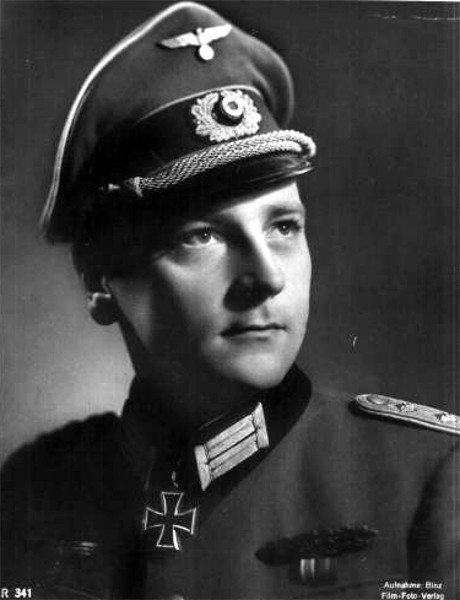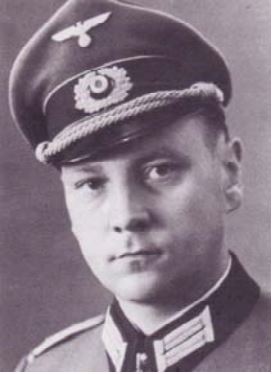Ammer, Hermann (Grenadier-Regiment 62)
- Date of birth:
- March 8th, 1914 (Mamming/Bavaria, Germany)
- Date of death:
- December 9th, 2000 (Vilshofen, Germany)
- Nationality:
- German
Biography
Promotions:
1935: Gefreiter d.R. und ROA
1937: Unteroffizier d.R.
1940: Feldwebel d.R.
1940: Leutnant d.R.
1942: Oberleutnant d.R.
1943: Hauptmann d.R.
1944: Major d.R.
Career:
01.10.1934-12.10.1935: 19./ Infanterie-Regiment Regensburg
30.08.1939: 2./ Infanterie-Regiment 179
06.02.1940-16.06.1940: Lehrgang - Waffenschule Döberitz
27.06.1940: Führer - 2./ Infanterie-Regiment 179
Chef - 3./ Infanterie-Regiments 62
00.00.1941: Führer - Stab II./ Infanterie-Regiment 62
29.10.1943: Führer - Stab II./ Grenadier-Regiments 62
Do you have more information about this person? Inform us!
- Period:
- Second World War (1939-1945)
- Rank:
- Leutnant der Reserve (2nd Lieutenant of Reserves)
- Unit:
- I./ Inf.Reg. 62, 7. ID
- Awarded on:
- July 2nd, 1941
- Period:
- Second World War (1939-1945)
- Rank:
- Leutnant der Reserve (2nd Lieutenant of Reserves)
- Unit:
- I./ Infanterie-Regiment 62, 7. ID
- Awarded on:
- October 18th, 1941
- Period:
- Second World War (1939-1945)
- Rank:
- Oberleutnant der Reserve (1st Lieutenant of Reserves)
- Unit:
- 3./ Grenadier-Regiment 62, 7. Infanterie-Division
- Awarded on:
- May 17th, 1943
- Period:
- Second World War (1939-1945)
- Rank:
- Oberleutnant der Reserve (1st Lieutenant of Reserves)
- Unit:
- 3./ Grenadier-Regiment 62, 7.Infanterie-Division
- Awarded on:
- September 7th, 1943
- Period:
- Second World War (1939-1945)
- Rank:
- Oberleutnant der Reserve (1st Lieutenant of Reserves)
- Unit:
- Führer, II./ Grenadier-Regiment 62, 7. Infanterie-Division
- Awarded on:
- October 12th, 1943
“On the 03.09.1943, II. Bataillon had the mission of taking the village of Chisky (Ssewsk area) in conjunction with its assigned heavy weapons and I. Bataillon.
The Bataillon began advancing northeastwards on the left side of the road at around 10:00, and as it did so friendly ground attack aircraft delivered effective support with their bombs and on-board weaponry. Hauptmann Ammer (commander of II. Bataillon) immediately recognized that the numerically superior enemy (6 battalions) could only be ejected with a particularly aggressive attack. However this was a difficult (if not impossible) expectation. The men had been exhausting by the retreat battles of the last days and weeks, and by now they were demoralized as well as exhausted on both a physical and mental level.
The friendly aircraft used their bombs and guns to force the enemy into cover just as the Bataillon was approaching to within 150 metres of the foremost enemy rifle and anti-tank gun positions. It was at this moment that Hauptmann Ammer decided to press his advantage and storm forward with his Bataillon. He and his Bataillon staff charged along the road with cries of ‘Hurra’ to the first enemy positions, captured an anti-tank gun and immediately turned it against its previous owners. The friendly riflemen hesitated at first, however they were inspired by the example of Hauptmann Ammer and became possessed of fiery enthusiasm. This attacking spirit also carried over to I. Bataillon, which was attacking along the right side of the road. With one stroke the southern village edge (the attack objective) was reached with only minimal losses of 4 lightly wounded men. The enemy was totally surprised and fled northwards towards the Ssejm river. They left behind 2 artillery pieces, 4 anti-tank guns, several MGs/MPs and numerous horses/vehicles.
Through his example, Hauptmann Ammer had led both the Bataillon and the Regiment to a most unexpected victory, and one in which he had the lion’s share.
The expected counterattack was not long in coming. At 14:00 on the following day the enemy attacked from the northwest with 150 men. They achieved a penetration and ejected 2 squads out of their positions. Hauptmann Ammer rushed to the area, rallied the remnants of the 2 squads and initiated a counterthrust with cries of ‘Hurra’. He was dissuaded by neither the enemy fire or their superiority, instead throwing them back and recapturing the lost ground. This deed was a decisive success.”
- Period:
- Second World War (1939-1945)
- Rank:
- Hauptmann (Captain)
- Unit:
- Führer, 3./ Grenadier-Regiment 62
- Awarded on:
- January 3rd, 1944
- Period:
- Second World War (1939-1945)
- Rank:
- Hauptmann (Captain)
- Unit:
- Führer, 3./ Infanterie-Regiment 62
- Awarded on:
- January 3rd, 1944
- Period:
- Second World War (1939-1945)
- Rank:
- Oberleutnant der Reserve (1st Lieutenant of Reserves)
- Awarded on:
- July 1st, 1942
- Period:
- Second World War (1939-1945)
- Rank:
- Oberleutnant der Reserve (1st Lieutenant of Reserves)
- Unit:
- Chef, II./ Infanterie-Regiment 62, 7. ID
- Awarded on:
- August 6th, 1943
- Period:
- Second World War (1939-1945)
- Rank:
- Hauptmann der Reserve (Captain of Reserves)
- Unit:
- Führer, Grenadier-Regiment 62, 7. Infanterie-Division
- Awarded on:
- April 1st, 1944
- Period:
- Second World War (1939-1945)
- Rank:
- Leutnant der Reserve (2nd Lieutenant of Reserves)
- Unit:
- I./ Infanterie-Regiment 62, 7. ID
- Awarded on:
- November 20th, 1941
Sources
- Photo 1: Willi Schumacher collection
- Photo: Willi Schumacher Collection
- http://www.ritterkreuztraeger.info/rk/a/A056Ammer.pdf
- TITLE - - THOMAS, FRANZ & WEGMANN, GüNTER, Die Ritterkreuzträger der Deutschen Wehrmacht 1939-1945, Biblio-Verlag, Osnabrück, 1987.
- Die Ordensträger der Deutschen Wehrmacht (CD), VMD-Verlag GmbH, Osnabrück, 2002
- Fellgiebel W.P., Elite of the Third Reich, The recipients of the Knight's Cross of the Iron Cross 1939-1945: A Reference, Helion & Company Limited, Solihull, 2003, ISBN 1-874622-46-9
- Patzwall K., Scherzer V., Das Deutsche Kreuz 1941-1945, Geschichte und Inhaber Band II, Verlag Klaus D. Patzwall, Norderstedt, 2001, ISBN 3-931533-45-X
- Axis Biographical Research
- Axis History Biographical Research via Axis History Forum
- Verleihungsurkunde EK1 dd. 18-10-1941
- Verleihungsurkunde NKSiB dd. 03-01-1944
- Verleihungsurkunde NKSiS dd. 03-01-1944
- Hermann Ammer | Military Wiki | Fandom














